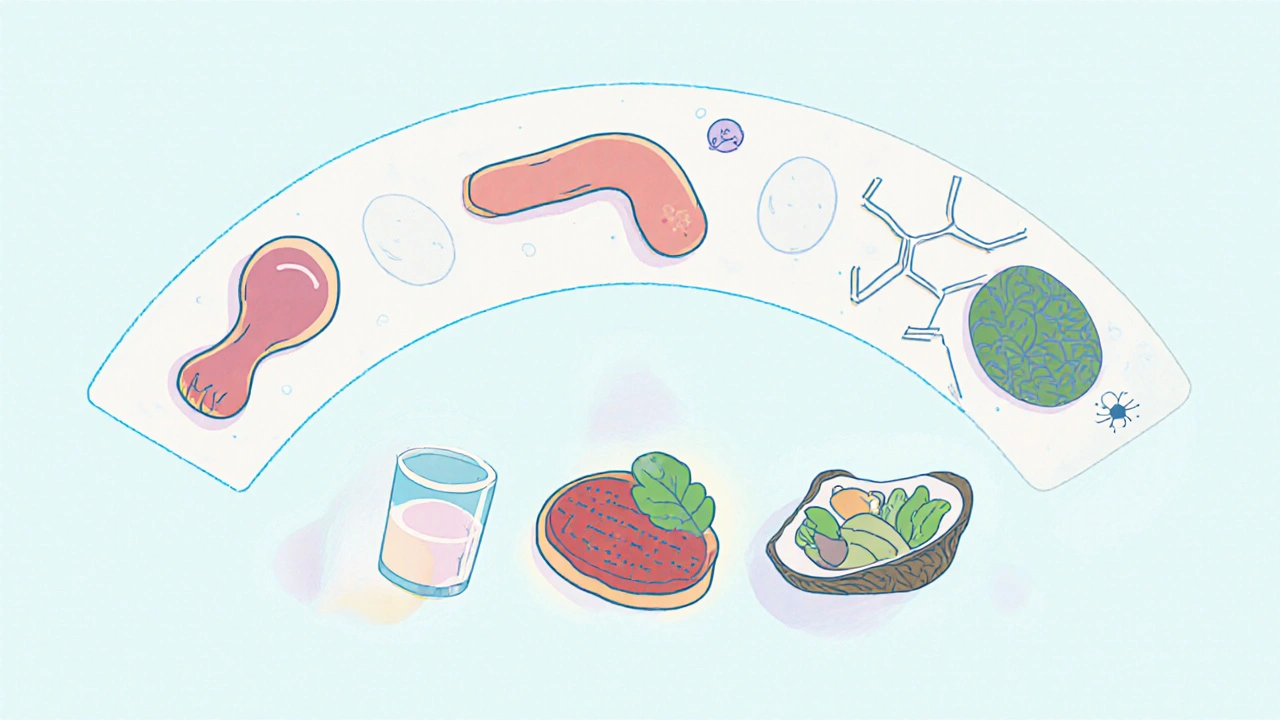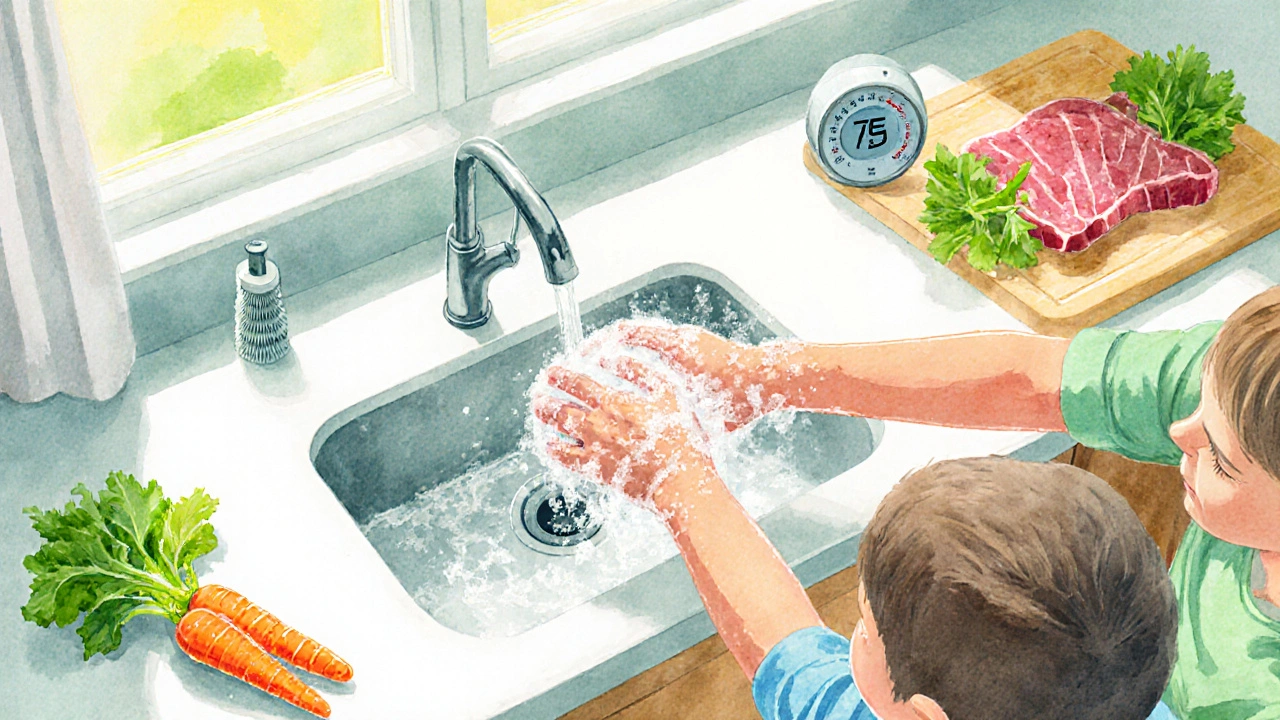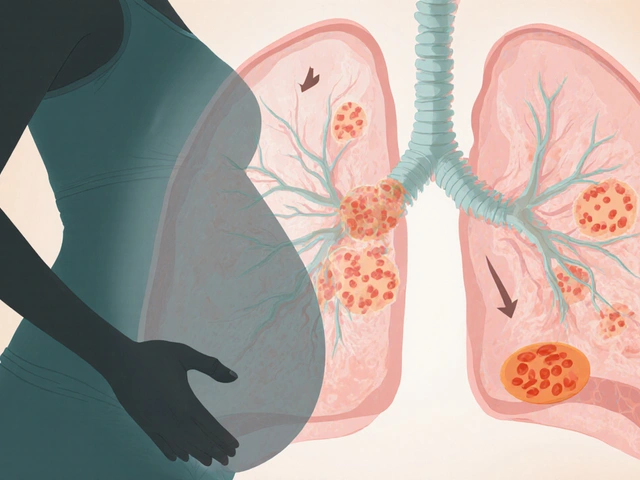Enteric Infection Symptom Checker
Select Your Symptoms
Choose symptoms you've experienced within the last 24 hours:
When your gut starts acting up, it’s easy to write it off as a bad night out or a harmless bug. But some infections strike early, and catching the warning signs can stop a nasty illness before it spirals. Below you’ll learn the exact clues to look for, how to gauge severity, and when to call a doctor.
Key Takeaways
- Early symptoms often appear 6‑48 hours after exposure and include sudden stomach cramps, watery diarrhea, and low‑grade fever.
- Distinguish infection from simple indigestion by watching for rapid onset, multiple stools, and signs of dehydration.
- If you notice blood, high fever, or persistent vomiting, seek medical help within 24hours.
- Simple home monitoring - fluid intake, temperature checks, and stool tracking - can guide your next steps.
- Good hygiene and safe food handling cut the risk of most enteric infections.
Enteric infections are a group of illnesses that affect the gastrointestinal tract, usually after eating or drinking contaminated food or water. They’re caused by bacteria, viruses, or parasites that invade the intestinal lining, leading to inflammation, fluid loss, and a range of uncomfortable symptoms. The term covers everything from classic food‑borne bacterial outbreaks to viral gastroenteritis that spreads in schools or care homes. Knowing the early warning signs lets you act before dehydration, electrolyte imbalance, or severe infection sets in.
Common Pathogens and Their Early Clues
| Pathogen | Typical Incubation | Early Symptoms (first 48h) | Common Sources |
|---|---|---|---|
| Salmonella | 6‑72h | Sudden cramps, watery diarrhea, mild fever | Undercooked poultry, eggs, contaminated produce |
| Escherichia coli (STEC) | 1‑3days | Severe cramps, bloody stools may appear early, low‑grade fever | Raw beef (especially ground), unpasteurized juice |
| Campylobacter | 2‑5days | Crampy pain, watery/bloody diarrhea, fever | Poultry, unpasteurized milk, contaminated water |
| Shigella | 1‑3days | Fever, abdominal pain, watery → bloody diarrhea | Fecal‑oral exposure, salads, ready‑to‑eat foods |
| Norovirus | 12‑48h | Nausea, vomiting, watery diarrhea, low‑grade fever | Contaminated shells, buffets, close‑contact settings |

Spotting the Early Symptoms
While each pathogen has its nuances, the early signs share a familiar pattern. Below is a quick checklist you can use the moment you feel something off.
- Sudden abdominal cramps - often a “stabbing” sensation that arrives within hours of eating.
- Watery or loose stools - more than two loose motions in a short period.
- Low‑grade fever - usually 37.5‑38.5°C (99.5‑101.3°F).
- Nausea or mild vomiting - not yet severe enough to keep you from drinking water.
- Feeling unusually thirsty - a signal that fluid loss is starting.
If you notice two or more of these signs within 24hours after a risky meal, treat it as a potential early enteric infection.
How to Monitor at Home
- Record the time you ate the suspect food and the exact symptoms that appear.
- Check temperature every 4hours; note any rise above 38°C.
- Track stool frequency and consistency using a simple chart (e.g., “1‑watery, 2‑normal, 3‑bloody”).
- Maintain fluid intake: aim for at least 1L of oral rehydration solution or clear broth per day.
- Watch for red flags - blood in stools, vomiting that prevents fluid intake, dizziness, or a temperature >39°C.
Keeping this log makes it much easier for a clinician to decide if you need a stool culture, rapid antigen test, or immediate treatment.

When to Seek Professional Care
Most mild infections resolve within 48‑72hours with rest and hydration. However, you should contact a healthcare provider if any of the following appear:
- Blood or mucus in stool that persists beyond 24hours.
- Fever climbs above 39°C or lasts more than 48hours.
- Vomiting prevents you from keeping fluids down for more than 12hours.
- Signs of dehydration - dry mouth, reduced urine output, dizziness, or rapid heartbeat.
- Symptoms last longer than a week, suggesting a more serious pathogen or complication.
In a clinic, the doctor may order a stool culture, a rapid PCR test, or basic blood work to rule out severe infection.
Preventing Future Infections
Prevention works best when you combine basic hygiene with smart food choices.
- Wash hands with soap for at least 20seconds after using the toilet and before handling food.
- Cook poultry, eggs, and ground meats to an internal temperature of 75°C (165°F).
- Avoid raw milk and unpasteurized juices.
- Rinse fruits and vegetables under running water; use a brush for firm produce.
- Keep raw meat separate from ready‑to‑eat foods in the fridge.
Even simple steps can cut the risk of the most common enteric pathogens by up to 70%.
Frequently Asked Questions
How soon after eating contaminated food do symptoms appear?
Incubation periods vary. Bacterial agents like Salmonella can cause symptoms in 6‑72hours, while Norovirus may show up within 12‑48hours.
Is watery diarrhea always a sign of infection?
Not always. Stress, medication side‑effects, or food intolerance can cause loose stools. The key is sudden onset, frequency, and accompanying fever or cramps, which point toward an infection.
Can I treat an early enteric infection at home?
Mild cases often resolve with rest, oral rehydration, and a bland diet. Antibiotics are only needed for specific bacteria (e.g., severe Shigella infections) and must be prescribed.
What is the best way to stay hydrated during diarrhea?
Sip small amounts of oral rehydration solution (ORS) or clear broth every 15‑20minutes. Avoid sugary drinks, caffeine, and alcohol, which can worsen fluid loss.
When should I call emergency services?
If you notice signs of severe dehydration (dry skin, fainting), persistent vomiting, high fever (>39.5°C), or blood‑filled stools, seek urgent medical care.







Gary Levy
October 9, 2025 AT 17:55 PMI’ve seen a few cases where sudden cramps and the first wave of watery diarrhea showed up just hours after a street‑taco night, and the key was catching the fever early. The trick is to log the exact time you ate, track temperature every few hours, and keep sipping oral rehydration. A quick check on the symptom list can save you a trip to the ER.
sourabh kumar
October 9, 2025 AT 23:28 PMMan I was eating that spicy biryani then boom my stomach started hurting out of nowhere I thought it was just too much pepper but then the bathroom became my second home I was like why is this happening and then I remembered the article about early signs of enteric infections
Christian Miller
October 10, 2025 AT 05:01 AMIt is noteworthy that the dissemination of such symptom checkers often coincides with the introduction of proprietary diagnostic kits, which raises questions regarding the motivations of pharmaceutical conglomerates seeking to monetize early detection.
NORMAND TRUDEL-HACHÉ
October 10, 2025 AT 10:35 AMHonestly the guide reads like a kindergarten handout; anyone with basic medical knowledge can see that the real nuance is missing.
AJIT SHARMA
October 10, 2025 AT 16:08 PMOur own health systems should not be dictated by foreign drug lobbies; we must rely on indigenous knowledge and clean water.
Neber Laura
October 10, 2025 AT 21:41 PMYour patriotic spiel ignores the data – dehydration kills, period.
Karen Nirupa
October 11, 2025 AT 03:15 AMWhile the overview may appear elementary, it serves an important educational function for diverse cultural audiences who might otherwise lack access to such health literacy.
Quinn Comprosky
October 11, 2025 AT 08:48 AMHey, I totally get how unsettling those first cramps can feel, especially when you’re not sure if it’s just a bad night out or something more insidious. The key, as the article points out, is timing – symptoms that slam in within a few hours after a questionable meal are a red flag.
First, jot down the exact time you ate that suspect food; this timestamp becomes your anchor for everything that follows.
Second, start checking your temperature every four hours – a low‑grade fever can be the silent sidekick of an infection.
Third, count your stools – more than two loose motions in a short span is a sign your gut is battling something.
Don’t ignore the thirst factor; if you’re unusually parched, it’s a sign you’re losing fluids fast.
Hydration is your first line of defense – sip oral rehydration solutions or clear broth regularly, even if you don’t feel thirsty yet.
If you notice any blood, persistent vomiting, or a fever over 39 °C, treat that as an urgent call to medical care – waiting can turn a manageable infection into a serious one.
For milder cases, rest, bland food, and continued fluid intake usually do the trick within 48–72 hours.
Keep a simple log: food, time, symptoms, temp, stool consistency. This log not only helps you track progression but also gives a clinician a clear picture if you end up seeking professional help.
Finally, remember that good hygiene and proper food handling are the best preventative tools – wash hands, cook meats thoroughly, and keep raw foods separate.
Stay vigilant, stay hydrated, and trust your body’s signals.
Thomas Ruzzano
October 11, 2025 AT 14:21 PMYour anecdote sounds like an over‑dramatized nightmare, yet it perfectly illustrates why the layperson must respect the microscopic tyrants lurking in our meals.
Dan Tenaguillo Gil
October 11, 2025 AT 19:55 PMLet me add a step‑by‑step perspective that might help shape a more structured response to any early enteric episode.
1. Immediately after the first symptom, record the exact time and what you ate – this is crucial for incubation window analysis.
2. Begin a systematic temperature check every two to four hours; note any upward trend even if it stays below 38 °C initially.
3. Track stool frequency and appearance in a simple chart – plain, watery, or blood‑tinged – as this guides urgency.
4. Hydrate proactively: aim for at least one liter of oral rehydration solution per day, adjusting for any vomiting episodes.
5. If vomiting prevents fluid intake for more than twelve hours, consider anti‑emetic advice from a pharmacist or tele‑health service.
6. Assess for red flags – blood, high fever (>39 °C), dizziness, rapid heartbeat – and seek immediate care if any appear.
7. Use the symptom checklist as a communication aid when you visit a clinician; it streamlines diagnostic decisions and may reduce unnecessary testing.
8. After recovery, reflect on the exposure source and reinforce preventive habits: thorough washing of produce, proper cooking temperatures, and safe water sources.
These steps not only mitigate the current episode but also empower you with a reproducible framework for future incidents.
Tiffany Owen-Ray
October 12, 2025 AT 01:28 AMFrom a philosophical standpoint, the body’s reaction to microbial invasion can be viewed as a dialogue between self‑preservation and external challenge. Recognizing the early whispers of that dialogue – a cramp, a sudden need for the restroom, a subtle rise in temperature – allows us to engage proactively rather than reactively. The article’s checklist provides a concrete vocabulary for this silent conversation, translating vague discomfort into actionable data. In practice, this means we become co‑authors of our health narrative, capturing each symptom with intention and thereby shaping the story’s outcome toward recovery. Moreover, by sharing such structured observations with healthcare professionals, we elevate the collective understanding of enteric patterns, contributing to a broader epidemiological insight that benefits the community at large. Ultimately, the act of mindful monitoring becomes a form of self‑respect and civic responsibility, reminding us that personal health is intertwined with public well‑being.
Jill Brock
October 12, 2025 AT 07:01 AMThis is a disaster!